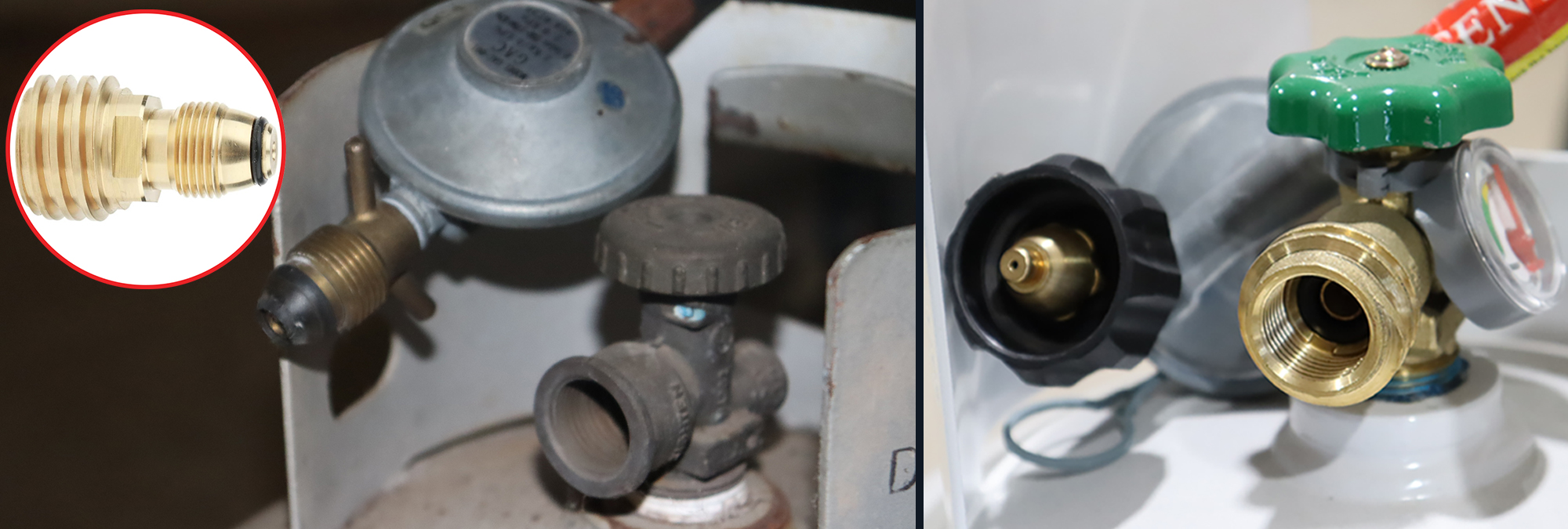Don’t use portable LP gas cylinder adaptors
The purpose of this Safety Alert is to warn owners of LP gas appliances that use small portable LP gas cylinders (9kg and under) not to use adaptors to connect appliances with the new LCC27 appliance connector to gas cylinders fitted with the type 21 POL cylinder connection.
Background
A Perth home owner received severe burns last month while using a barbecue. Initial findings from the Western Australian investigation found that while the new gas appliance was fitted with the new LCC27 appliance connector, an adaptor used caused the safety valve to not operate.
Due to the high risk of serious injury from a similar incident, information of the Western Australian incident has been shared amongst Gas Regulatory Authorities in Australia and New Zealand to issue alerts.
Changes to LP gas cylinder connections
Type 21 POL has been the standard cylinder connection used in small portable LP gas cylinders in Australia. The Australian Standards were changed on 1 October 2020 to phase out the type 21 POL cylinder connection and transition to the safer LCC27 cylinder connection.
A 10 year transition period is in place to accommodate the testing and changeover period for LP gas cylinders, with the following key dates:
- From 1 October 2021, it is mandatory on all new or retested portable LP gas cylinders to have the LCC27 cylinder connection fitted; and
- From 1 April 2021, all new LP gas appliances sold must be fitted with the LCC27 appliance connector.

Type 21 POL appliance connectors are cross compatible with the LCC27 cylinder connection, but the LCC27 appliance connector is not compatible with the type 21 POL cylinder connection. As a result, non-approved aftermarket adaptors have appeared on sale to address the non-compatibility.
Possible contributing factors
- LCC27 appliance connectors are not compatible with type 21 POL cylinder connection.
- An adaptor was used to connect the barbecue’s LCC27 appliance connectors which caused the safety valve to not operate.
- The threads on a type 21 POL valve are left handed, while the threads on a LCC27 valve are right handed, which makes it difficult to seal them together.
- There is a risk that tightening the LCC27 appliance connector onto an adaptor may loosen the POL connection at the cylinder due to the opposing threads, which can cause a gas leak.
Action required
- Do not use adaptors to connect LCC27 appliance connectors to older type 21 POL cylinder connections and stop using any gas appliance fitted with an adaptor.
- Australian standard AS/NZS1596, which has been called up under the Northern Territory’s Dangerous Goods laws prohibits the use of adaptors in this manner.
- If you use the Swap ‘n’ Go exchanges to refill LP gas cylinders, make sure the full bottle you receive is fitted with the LCC27 cylinder connection.
- If you own your portable LP gas cylinders, upgrade your cylinder to one with the new LCC27 cylinder connection which has the following safety features:
- The LCC27 cylinder connection has an internal safety release valve that will only open and allow gas to flow when an appliance connector has been connected.
- The rubber seal is located inside the cylinder connection and protected from exposure, so it is less likely to deteriorate.
- The LCC27 appliance connector has a thermal cut-off which will stop gas from flowing if there is a fire.
Further information
For further information, please refer to the following:
Safety Alert
- Summer safety warning for the use of LP gas adaptors (WA Department of Energy, Mines, Industry Regulation and Safety)
Guidance information
- Transitional requirements for the implementation of the new LCC27 LPG cylinder connection (Gas Technical Regulators Committee)
- LP gas cylinder adaptors that convert old POL to LCC27 banned in Western Australia (WA Department of Energy, Mines, Industry Regulation and Safety)
Australian Standards
- AS/NZS1596:2014 The storage and handling of LP Gas (Standards Australia)
Disclaimer
This Safety Alert contains safety information following inquires made by NT WorkSafe about an incident or unsafe practice. The information contained in this Alert does not necessarily include the outcome of NT WorkSafe’s action with respect to an incident. NT WorkSafe does not warrant the information in this Alert is complete or up-to-date and does not accept any liability for the information in this report or as to its use.